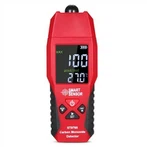Introduction to the principle of thermal sensitive probes for anemometers
The basic principle of an anemometer is to place a thin metal wire in a fluid and heat the wire with an electric current to make its temperature higher than the temperature of the fluid. Therefore, the metal wire anemometer is called a "hot wire". When the fluid flows through the metal wire in a vertical direction, it will take away some of the heat from the wire, causing the temperature of the wire to decrease. According to the theory of forced convection heat exchange, it can be derived that there is a relationship between the heat dissipated by the hot wire Q and the velocity v of the fluid. A standard hot wire probe consists of two brackets tensioned with a short and thin metal wire. Metal wires are commonly made of metals with high melting points and good ductility, such as platinum, rhodium, and tungsten. The commonly used wire diameter is 5 μ m. 2mm long; The small probe diameter is only 1 μ m. The length is 0.2mm.
According to different purposes, the hot wire probe can also be made into double wire, triple wire, oblique wire, V-shaped, X-shaped, etc. In order to increase strength, metal film is sometimes used instead of metal wire, and a thin metal film is usually sprayed on a thermally insulated substrate, called a hot film probe, as shown in Figure 2.2. The hot wire probe must be calibrated before use. Static calibration is carried out in a specialized standard wind tunnel, measuring the relationship between flow velocity and output voltage and drawing a standard curve; Dynamic calibration is carried out in a known pulsating flow field, or by adding a pulsating electrical signal to the heating circuit of the anemometer to verify the frequency response of the hot wire anemometer. If the frequency response is poor, corresponding compensation circuits can be used to improve it.
The measurement range of flow velocity from 0 to 100m/s can be divided into three sections: low speed: 0 to 5m/s; Medium speed: 5 to 40m/s; High speed: 40 to 100m/s. The thermal sensitive probe of the anemometer is used for measurements from 0 to 5m/s; The rotary probe of the anemometer has an ideal effect in measuring flow velocities ranging from 5 to 40m/s; By using a pitot tube, results can be obtained within a high-speed range. An additional standard for selecting the flow rate probe of an anemometer correctly is temperature, which is typically used by the thermal sensor of the anemometer at temperatures of approximately+-70C. The rotor probe of the specially designed anemometer can reach 350C. Pitot tubes are used for temperatures above+350C.
Thermosensitive probe of anemometer
The working principle of the thermal sensitive probe of the anemometer is based on the cold impact airflow taking away the heat on the thermal element. With the help of a regulating switch, the temperature is kept constant, and the regulating current is proportional to the flow rate. When using a thermosensitive probe in turbulence, airflow from all directions simultaneously impacts the thermal element, which can affect the accuracy of the measurement results. When measuring in turbulence, the reading of the flow velocity sensor of the thermal anemometer is often higher than that of the rotary probe. The above phenomena can be observed during pipeline measurement. According to different designs for managing pipeline turbulence, it can even occur at low speeds. Therefore, the anemometer measurement process should be carried out on the straight section of the pipeline. The starting point of the straight section should be at least 10 times before the measurement point × D (D=pipeline diameter, in CM); The endpoint should be at least 4 after the measurement point × Location D. The fluid cross-section must not have any obstruction. (edges, overhangs, objects, etc.)
The working principle of the rotary probe of the anemometer is based on converting the rotation into an electrical signal. First, it passes through a proximity sensing start to "count" the rotation of the rotary wheel and generate a pulse series. Then, it is converted and processed by the detector to obtain the speed value. The large-diameter probe of the anemometer (60mm, 100mm) is suitable for measuring turbulence at medium and small flow rates (such as at pipeline outlets). The small caliber probe of the anemometer is more suitable for measuring airflow with a cross-sectional area greater than 100 times that of the exploration head.






